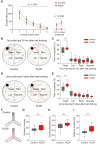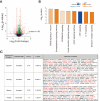Enhancement of memory and emotional functions by long-term ingestion of protease-treated porcine liver extract in mice
- PMID: 40436945
- PMCID: PMC12119931
- DOI: 10.1038/s41598-025-03362-4
Enhancement of memory and emotional functions by long-term ingestion of protease-treated porcine liver extract in mice
Abstract
The relationship between diet and brain functions has garnered attention. Previous studies have shown that ingesting a protease-treated porcine liver decomposition product (PLDP) improves cognitive function in humans. In this study, we investigated the effects of PLDP ingestion on cognitive and emotional functions in mice. Mice were fed a PLDP-enhanced diet for 16 weeks and subjected to various behavioral assessments. PLDP ingestion enhanced long-term memory in Barnes maze test. Moreover, mice fed the PLDP diet exhibited reduced anxiety- and depression-like behaviors as evidenced by their performance in open-field, elevated plus maze, marble-burying, and forced swim tests. They also increased locomotor activity. RNA sequencing analysis of the brain tissue revealed substantial changes in gene expression, particularly in pathways associated with learning, memory, and anxiety regulation. Collectively, these results suggest that PLDP induces changes in gene expression associated with brain function, potentially contributing to the enhancement of cognitive function and psychological health. Furthermore, our findings not only enhance our understanding of the relationship between nutrition and brain function but also indicate the potential of interventions utilizing dietary components, such as PLDP, to support cognitive function and psychological health.
Keywords: Anxiety; Locomotor activity; Memory; Nutrition; Porcine liver.
© 2025. The Author(s).
Conflict of interest statement
Declarations. Competing interests: Y.M. received a scholarship grant from Sugar Lady Cosmetics Co., Ltd., which also provided the PLDP-containing capsules used in this study. Y.M. received honoraria for participating in speakers’ bureaus, and T.U. and Y.M. hold a patent on PLDP. All other authors declare no conflict of interest. Ethics approval for animal experiments: All animal experiments were conducted in accordance with the Guidelines for the Care and Use of Laboratory Animals of Nihon Pharmaceutical University. The protocols were approved by the Committee for Animal Experiments at Nihon Pharmaceutical University (approval numbers AE2020-009 and AE2021-018). All animal experiments strictly followed national and international guidelines, and the study was designed, conducted, and reported in accordance with ARRIVE guidelines ( https://arriveguidelines.org ), ensuring high standards of animal welfare and ethics.
Figures






Similar articles
-
Oral administration of porcine liver decomposition product for 4 weeks enhances visual memory and delayed recall in healthy adults over 40 years of age: A randomized, double-blind, placebo-controlled study.Exp Gerontol. 2020 Nov;141:111064. doi: 10.1016/j.exger.2020.111064. Epub 2020 Aug 22. Exp Gerontol. 2020. PMID: 32841683 Clinical Trial.
-
Long-term (15 mo) dietary supplementation with pomegranates from Oman attenuates cognitive and behavioral deficits in a transgenic mice model of Alzheimer's disease.Nutrition. 2015 Jan;31(1):223-9. doi: 10.1016/j.nut.2014.06.004. Epub 2014 Jun 25. Nutrition. 2015. PMID: 25441596
-
Administration of Allium cepa L. bulb attenuates stress-produced anxiety and depression and improves memory in male mice.Metab Brain Dis. 2018 Feb;33(1):271-281. doi: 10.1007/s11011-017-0159-1. Epub 2017 Nov 25. Metab Brain Dis. 2018. PMID: 29178012
-
Comprehensive behavioral analysis of the Cdkl5 knockout mice revealed significant enhancement in anxiety- and fear-related behaviors and impairment in both acquisition and long-term retention of spatial reference memory.PLoS One. 2018 Apr 27;13(4):e0196587. doi: 10.1371/journal.pone.0196587. eCollection 2018. PLoS One. 2018. PMID: 29702698 Free PMC article.
-
Beneficial Effects of Walnuts on Cognition and Brain Health.Nutrients. 2020 Feb 20;12(2):550. doi: 10.3390/nu12020550. Nutrients. 2020. PMID: 32093220 Free PMC article. Review.
References
-
- Maher, T. J. Effects of nutrients on brain function. Prog. Brain Res.122, 187–194 (2000). - PubMed
-
- Vauzour, D. et al. Nutrition for the ageing brain: Towards evidence for an optimal diet. Ageing Res. Rev.35, 222–240 (2017). - PubMed
-
- Ekstrand, B. et al. Brain foods—The role of diet in brain performance and health. Nutr. Rev.79, 693–708 (2021). - PubMed
MeSH terms
Substances
Grants and funding
LinkOut - more resources
Full Text Sources
Medical

